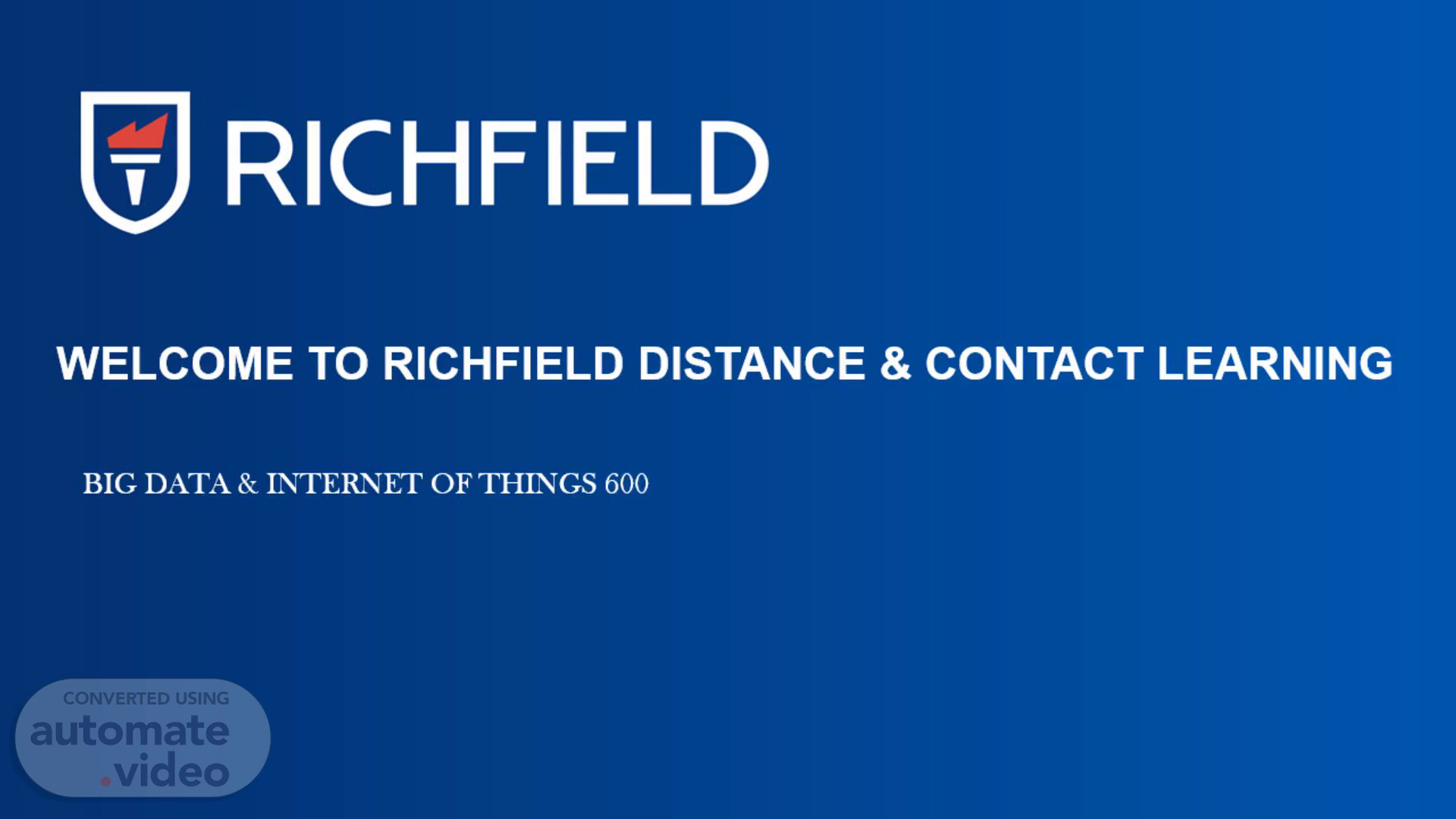Scene 1 (0s)
[Audio] WELCOME TO RICHFIELD DISTANCE & CONTACT LEARNING BIG DATA & INTERNET OF THINGS 600.
Scene 2 (7s)
[Audio] PRESCRIBED OR RECOMMENDED BOOKS Prescribed Textbook: Geng, H. (2017).Internet of Things and Data Analytics Handbook. United States: Wiley. ISBN:9781119173649 Recommended Reading: Big Data, IOT and Machine Learning Tools and applications ISBN:9780367336745 Here are the prescribed and recommended books..
Scene 3 (50s)
[Audio] BIG DATA & IOT 600 Chapter 1: Big Data Analysis and Extraction Techniques Chapter 2: IoT Architectures and Applications Chapter 3: IoT technologies and Standards Chapter 4: Big Data Storage and Security Chapter 5: Big Data ethics, standards and policies Our Module Big data & internet of things has the following topics, Chapter 1: Big Data Analysis and Extraction Techniques, Chapter 2: IoT Architectures and Applications, Chapter 3: IoT technologies and Standards, Chapter 4: Big Data Storage and Security, And lastly Chapter 5: Big Data ethics, standards and policies..
Scene 4 (1m 43s)
[Audio] Chapter 1 Big Data Analysis and Extraction Techniques Let's dive to Chapter 1, titled Big Data Analysis and Extraction Techniques..
Scene 5 (1m 55s)
[Audio] Learning Outcomes After reading this Section of the guide, the learner should be able to: Understand Big Data Concepts. Identify and describe common tools and frameworks used for big data analysis. Apply various Big Data techniques for analysis of knowledge to support business decisions. Understand the need for data cleaning, normalization, and transformation in big data workflows. Learning Objectives After this section, you will be able to: Understand key Big Data concepts Identify and describe common tools and frameworks for big data analysis Apply various Big Data techniques to analyze knowledge and support business decisions Recognize the importance of data cleaning, normalization, and transformation in big data workflows.
Scene 6 (2m 41s)
[Audio] Big Data is the term used to describe the application of specialized techniques to process very large sets of data, which are often too complex to process using regular database management tools. The challenges that big data solves include capture, storage, search, sharing, transfer, analysis, and visualization..
Scene 7 (3m 5s)
[Audio] Main characteristics of big data Volume Velocity Variety Veracity Value Volume, Velocity, Variety, Veracity, and Value.
Scene 8 (3m 15s)
[Audio] Sources of Big data Business Transaction, Social Media Platforms, Internet Of Things, Web and digital activity, Medical Records and Scientific Research.
Scene 9 (3m 26s)
[Audio] Common tools and frameworks used for big data analysis. Hadoop, Apache Spark, Apache Kafka, MongoDB, Tableau, Amazon Web Services (AWS) , Apache Flink, and Power BI. Hadoop is an open-source framework designed for storing and processing large datasets across distributed computing environments. Apache Spark complements Hadoop by providing fast, in-memory data processing capabilities, ideal for real-time analytics. Apache Kafka serves as a high-throughput messaging system that handles real-time data streaming and integration between systems. MongoDB is a popular NoSQL database known for its flexibility in managing unstructured data. Tableau and Power BI are powerful data visualization tools that help users create interactive and insightful dashboards for business intelligence. Amazon Web Services (AWS) offers a comprehensive suite of cloud computing services that support scalable storage, computing, and analytics solutions. Lastly, Apache Flink is a stream processing framework built for real-time data processing and analytics, enabling continuous computation over large data streams..
Scene 10 (4m 47s)
[Audio] Big Data Analysis Techniques: Descriptive analysis Predictive analysis Deep learning and Machine Learning (ML) Real-time analytics Sentiment analysis Descriptive analysis involves summarizing and interpreting historical data to understand past trends and patterns. Predictive analysis uses statistical models and machine learning techniques to forecast future outcomes based on existing data. Deep learning and Machine Learning (ML) are advanced artificial intelligence methods that enable computers to learn from data and make decisions with minimal human intervention. Real-time analytics refers to the processing and analysis of data as it is generated, allowing immediate insights and actions. Sentiment analysis is a technique used to interpret and classify emotions or opinions expressed in text data, often applied in social media monitoring and customer feedback analysis..
Scene 11 (5m 46s)
[Audio] Data Cleaning Finding and fixing mistakes, inconsistencies, and missing values in raw data is the goal of data cleaning..
Scene 12 (5m 56s)
[Audio] Data Normalization The goal is to standardize and scale data in order to facilitate efficient processing and comparison..
Scene 13 (6m 6s)
[Audio] Data Transformations The goal of data transformation is to transform unprocessed data into a format that may be used for analysis or model construction..
Scene 14 (6m 17s)
[Audio] Big Data Challenges Complexity: Data in different formats and structures (such as structured, semi-structured, and unstructured) must be handled by transformation pipelines. Real-Time Constraints: Workflows using streaming data require quick transformations. Resource Management: To reduce memory and computation consumption, large-scale transformations need to be optimized..
Scene 15 (6m 45s)
[Audio] Review questions What is Big Data, and what are its defining characteristics (e.g., the 3Vs or 5Vs)? Explain the difference between structured, unstructured, and semi-structured data. Describe how Big Data differs from traditional data management systems in terms of scale and processing. List at least three tools or frameworks commonly used for Big Data processing and describe their primary purposes. Compare Hadoop and Spark in terms of data processing capabilities and use cases. What is the role of NoSQL databases (e.g., MongoDB, Cassandra) in Big Data environments?.
Scene 16 (7m 26s)
[Audio] All the best with your studies!!!. All the best with your studies!!!.
